In June of 2006, I traveled to England on a McKnight/Arrowhead Regional Arts Council Fellowship Grant. The grant allowed me to study how willow is grown and cultivated for basket making and also to study the rush harvesting process and seat weaving techniques.
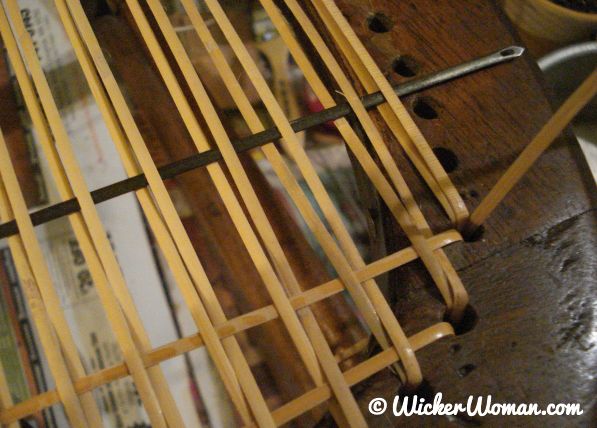
I spent ten delightful days with my host and President of the Basketmakers’ Association (BA), Olivia Elton Barratt. She took me all over England to see how both bulrush and willow are grown, harvested, processed, and used in weaving baskets and chair seats.
We even watched as a hot air balloon, capable of holding 12 people, was being woven out of skin-on rattan and watched as handwoven willow coffins were made at The Somerset Willow Company!
Weaving with English Rush
One day during my stay, Olivia was holding a regular weaving class at her home with two students. One of the gals was learning how to weave a bulrush chair seat and the other was weaving a dyed round reed basket.
Since I had made both hand-twisted cattail rush seats and round rattan reed baskets at home, Olivia asked me if I’d like to learn how to weave a rush boater’s hat.
Weaving a rush hat while using of this wonderful English rush was something I had never done before. I had only admired pictures of the lovely hats as I read the instructions in Olivia’s books that I had purchased years ago.
Of course, I agreed to take a rush boater’s hat lesson from Olivia! I had a wonderful time as she taught me how to weave this beautiful rush hat using the long, wide, and soft English rush that Olivia had prepared earlier that day!
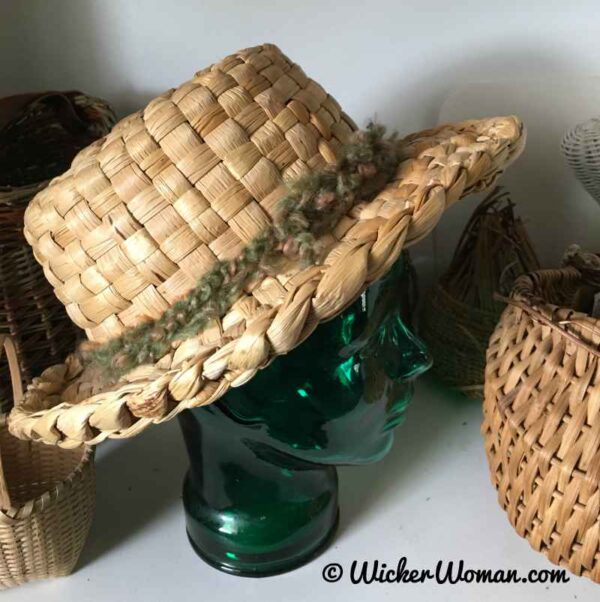
During the course of our conversation, the topic of using a chair caning needle on hole-to-hole chair caning came up. I was lamenting about how difficult it was to use one on a hole-to-hole cane seat. Because our American caning needles were so stiff and not flexible enough to bend in the intricate and tight weave.
American Chair Caning Needle
I prefer to use my American chair caning needle on a twill or herringbone pattern wide binding cane seat instead of on a hole cane seat. They work extremely well on the cane twill seat, acting as a shuttle to pass the cane through the weave.
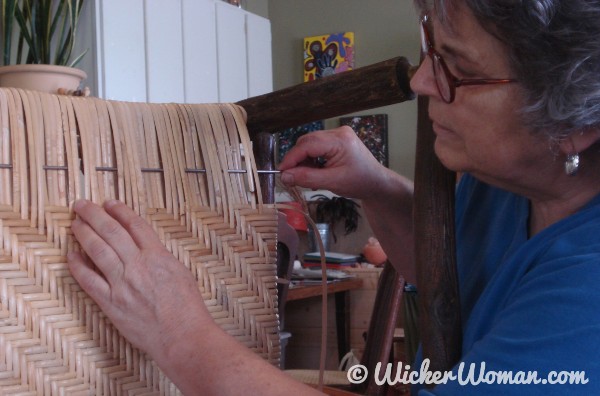
Using an English Chair Caning Needle
Olivia took out her English chair caning needle for me to examine and I was surprised at how different the English and American caning needles are. Their caning needles look nothing like ours and as she explained, are very easy to work with.
Also, when using a caning needle, they change the sequence of the seven chair caning weaving steps.
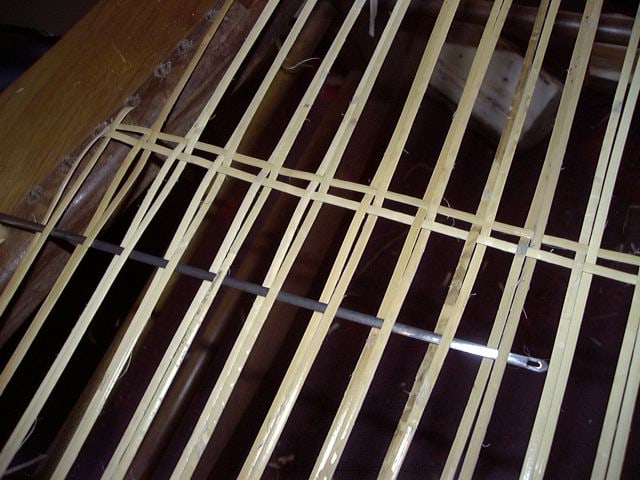
The vertical rows of steps #1 and #3 are put in first, and then using the caning needle, the horizontal rows of steps #2 and #4 are put in.
Lastly, all the diagonal steps of #5 and #6 and the remaining binder cord couching are all done by hand without the assistance of the needle.
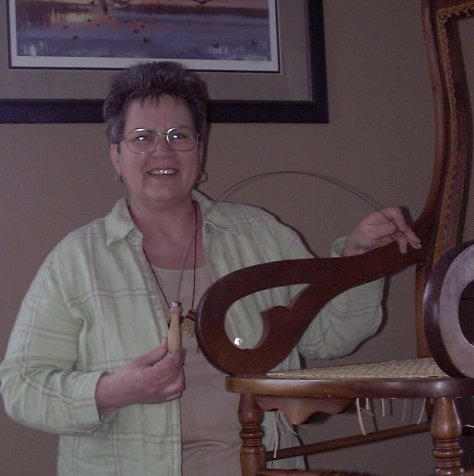
The English chair caning needles are made with a very fine, narrow metal that has a pointed (picket fence style) end with a rectangular hole in it (where you insert the end of a strand of cane to pull through the weave) and a wooden handle at the other end.
This needle is so fine and flexible that it can be manipulated well throughout the first four set-up stages of the traditional hand caning, leaving only the two diagonals and binder cord to weave without the tool.
Thank you, Olivia Elton Barratt, for presenting me with such a valuable tool, thanks for enlightening me! Now, how are we going to get this tool over here in America?
English Steamer for Chair Caning
These steamers are slightly different than the needle I got from Olivia; however, they are flat and thin, about 1/4″-1/2″ in width, and have no handle.
Each steamer has two bent ends that are tapered and have a hole in each end to hook the cane to pull through the weave. These steamers work really well and are a great asset to speed up the weaving process.
UPDATE NOTICE: The imported flat, 1/4″ wide English chair caning “steamers” are available for purchase through cane and basket supplier Peerless Rattan, listed in the Cane & Basket Supplies Directory™.
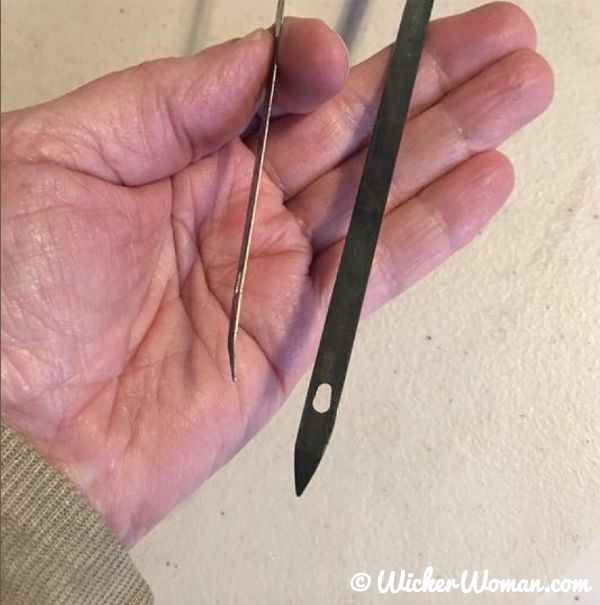
I will be switching to this tool for use on all my hole-to-hole caning because it certainly does speed up the weaving process!
And then keep my American caning needle to use for all the wide binding/porch cane weaving jobs where it works so well.

What is your experience weaving with the assistance of an English chair caning needle or steamer? Have you ever used one? Let me know in the comments below.

What are your thoughts about this blog post?
Leave your comments below and share with your social networks!
~~Live Well, Laugh Often, Love Much ~~
Happy Weaving, until next time!


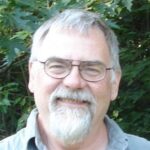


I’m confused as to how using a needle speeds up steps 1, 2, & 3. Doesn’t having to weave step 2 slow down the process compared to layering steps 1, 2, & 3?
Hi Karla,
Sorry for the confusion but when using the steamer or caning needle, you need to alter the sequence of the steps. Instead of weaving steps 1-6 in the normal sequence, you put in the two verticals of 1 & 3. Once those are in properly, you weave the two horizontals, steps 2 & 4, aided by the caning needle or steamer.
With the steamer you can thread the needle very quickly through the over and under weaves of step 2, hook the cane on the end of the steamer through the hole, and pull the cane through the row. Then you do the same thing with another strand of cane from the opposite side of the chair to weave the over and under of step 4, hook that strand of cane in the hole end of the steamer and pull through.
You are constantly weaving with the steamer from opposite sides of the seat and with two separate strands, to make sure the horizontal steps 2 & 4 are done correctly. And since you don’t need to hold on to the cane strands and thread them through individually as you do in the traditional pattern, but hook it into the needle and pull quickly through the verticals, it speeds up the process immensely.
Oops,
https://www.wickerwoman.com/articles/chair-caning-instruction
“sequence of the seven chair caning steps weaving steps”
on this page is the one that is broken.
Ruth,
I’m so sorry about that link error, there should have been an “s” on the end of the link. Proper link is https://www.wickerwoman.com/articles/chair-caning-instructions. Please try it again.
Catheryn my American caning needle is not wide enough for weaving 6 mm binder cane and the English steamers are 6mm wide. Are you aware of any similar tool that can manage 6mm binder?
Richard,
I don’t quite understand what you are talking about with the needles not being wide enough to handle 6MM cane. I have used both for years and never have a problem. Are you using to try and pull the 6MM binder through the rows? Maybe you are trying to use them in a way they are not designed for? The only way I use the American caning needle to weave binder cane seats is to run it through the warp strands and then turn the needle on its side to open up the weaving row so I can push the binder cane through. And I use the English caning needles and the flat English “steamers” needles to weave hole cane strands hooking the strand into the hole at the end and pulling it through. Weaving binder cord or porch cane seats using an American caning needle. Using English caning needles